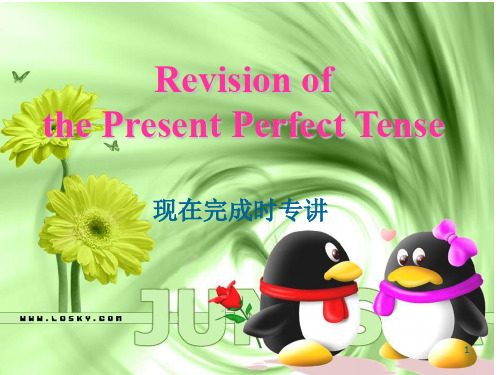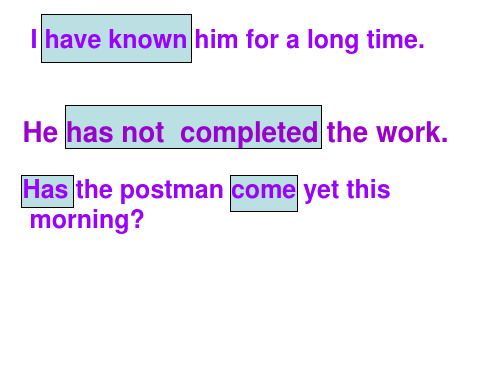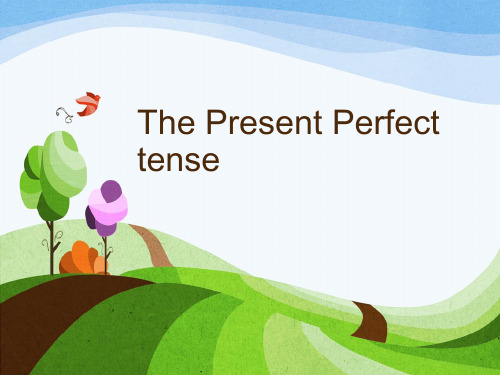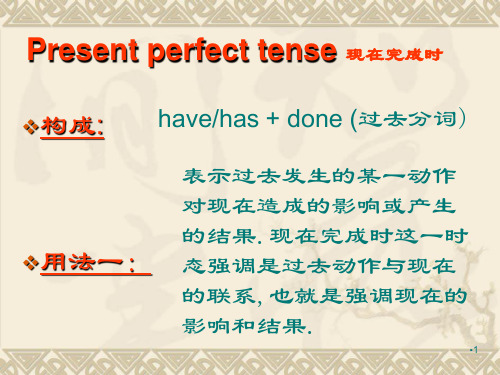现在完成时态公开课
合集下载
现在完成时讲解课件

1
2
现在完成时的主要用法
表示过去发生的某一动作对现在造成的影响或结果。
表示过去已经开始, 持续到现在的动作或状态,
表示人曾有过或到目前为止从未有过的经历
现在完成时的主要用法
现在完成时的运用(1): 在表示“用法1”时,现在完成时常和副词already, yet, never, ever ,before ,just等连用。
Eg. I haven’t had breakfast yet. Have you had breakfast yet?
否定句:句末 “还(没)”
yet在现在完成时中的用法
疑问句: 句末 “己经”
b) never 是否定词,表示“从来没有”,而ever 表示“曾经”
We have never been to the Great Wall. 我们从来没有去过长城。 Have you ever been to Canada? 你们曾经去过加拿大吗?
4. I __________ (read) the novel twice. It’s interesting. 5. She _________(go) to Pairs, hasn’t she? Yes. How ______ she _______(go) there? She _______(go) there by air. 6. So far, many countries _______________(develop) their software programs. 7.Mr Chen ______(give)up smoking last year. 8.Mr Chen __________(give) up smoking since last year.
刘欣现在完成时公开课

现在完成时(二)
1.现在完成时的第二种用法是什么? 2.常用的时间状语有哪些? 3.你能说出for 和since有什么不同吗?
现在完成时(二) ( present perfect tense)
past
present(now)
future
表示过去发生的动作,一直延续到现在.
read the book
have been to ,have gone to , have been in
现在完成时与一般过去时的区别
延续性动词与非延续性词
6
1
基本构成与句式变换
现在完成时谓语动词的构成:
助动词have/has +V (pp.)(过去分词) He/She/It has … I/ We/You/ They have … 1. I have _____________(finish) homework finished already. 2. He has ___________(learn) English for learned three years.
had (have) lunch ?” Have you ____ • 1. ---“___ ---“Yes.” did you _____ have (have) it?” ---“When ____ had (have) it at 12:00.” ---“I ___ Have you _____ written(write) a letter to • 2. ---“____ your aunt yet?” have I wrote ---“Yes, I ____. ____(write) one last week.”
【复习目标】
1、知识目标: (1)熟记不规则动词的过去分词 (2)现在完成时的构成形式。 2、能力目标: (1)能够正确使用already, yet, ever, never, just before, recently, lately等标志词做时态题。 (2)能够正确迅速区分: have gone to / have been to / have been in 。 (3)能够正确使用for和since引导的时间状语。 (4)能用现在完成时描写自己的经历。
现在完成时课件

详细描述
现在完成时可以用来描述一个动作从过去开始,一直持续到 现在,并且有可能继续下去。例如,“我已经学习英语三年 了。”这句话表示“学习英语”这个动作从三年前开始,一 直持续到现在,并且还有可能继续下去。
动作发生在过去,但与现在无关
总结词
表示某个动作发生在过去,与现在的情况无关。
详细描述
现在完成时也可以用来描述一个动作发生在过去,与现在的情况无关。例如,“我已经去过美国了。”这句话表 示“去美国”这个动作发生在过去,与现在的情况(如是否在美国)无关。
与already, just, yet等副词连用
表示动作或状态已经完成或尚未完成。
现在完成时可以与already, just, yet等副词连用,表示某个动作或状态已经完成或尚未完成。例如, “I have already finished my homework.”(我已经完成了作业。)“He hasn't yet arrived.”( 他还没到。)
表示某个动作对现在的情况有影响。
详细描述
现在完成时也可以用来描述某个动作 对现在的情况有影响。例如,“我已 经结婚了。”这句话表示“结婚”这 个动作已经完成,并且对现在的情况 (如婚姻状态)有影响。
动作发生在过去,持续到现在,并有可能持续下去
总结词
表示某个动作从过去开始,一直持续到现在,并且有可能继 续下去。
填空题2
She has read the book. She _______ it before the summer holiday.
翻译题练习
要点一
翻译题1
我已经完成了作业。
要点二
翻译题2
他们已经到达了机场。
THANKS
感谢观看
现在完成时可以用来描述一个动作从过去开始,一直持续到 现在,并且有可能继续下去。例如,“我已经学习英语三年 了。”这句话表示“学习英语”这个动作从三年前开始,一 直持续到现在,并且还有可能继续下去。
动作发生在过去,但与现在无关
总结词
表示某个动作发生在过去,与现在的情况无关。
详细描述
现在完成时也可以用来描述一个动作发生在过去,与现在的情况无关。例如,“我已经去过美国了。”这句话表 示“去美国”这个动作发生在过去,与现在的情况(如是否在美国)无关。
与already, just, yet等副词连用
表示动作或状态已经完成或尚未完成。
现在完成时可以与already, just, yet等副词连用,表示某个动作或状态已经完成或尚未完成。例如, “I have already finished my homework.”(我已经完成了作业。)“He hasn't yet arrived.”( 他还没到。)
表示某个动作对现在的情况有影响。
详细描述
现在完成时也可以用来描述某个动作 对现在的情况有影响。例如,“我已 经结婚了。”这句话表示“结婚”这 个动作已经完成,并且对现在的情况 (如婚姻状态)有影响。
动作发生在过去,持续到现在,并有可能持续下去
总结词
表示某个动作从过去开始,一直持续到现在,并且有可能继 续下去。
填空题2
She has read the book. She _______ it before the summer holiday.
翻译题练习
要点一
翻译题1
我已经完成了作业。
要点二
翻译题2
他们已经到达了机场。
THANKS
感谢观看
《现在完成时态》ppt课件

REPORT
现在完成时态
CATALOG
DATE
ANALYSIS
SUMMARY
目录
CONTENTS
• 现在完成时态的定义 • 现在完成时态的用法 • 现在完成时态与一般过去时的区别 • 现在完成时态的特殊用法 • 现在完成时态的练习与解析
REPORT
CATALOG
DATE
ANALYSIS
SUMMAR Y
翻译练习
总结词
跨文化理解
总结词
句型转换能力
详细描述
通过将英文句子翻译成中文,学生可以更 好地理解现在完成时态在中文表达中的对 应形式,促进跨文化交流和理解。
详细描述
翻译练习不仅要求学生掌握时态的转换, 还需要注意句型的变化和语言的流畅性, 有助于提高学生的语言运用能力。
REPORT
THANKS
感谢观看
用于描述过去发生的某个事件或经历, 并强调该事件或经历对现在的影响或 结果。
用于表达对过去某个时间点或时期的 情况的回忆或回顾。
REPORT
CATALOG
DATE
ANALYSIS
SUMMAR Y
03
现在完成时态与一般过 去时的区别
时间点的区别
01
过去时描述过去某个时间点发生 的事情,强调事情发生的时间点 。
CATALOG
DATE
ANALYSIS
SUMMAR Y
这个句子中的“Have you seen” 表示询问对方是否已经完成了动 作“看电影”,强调了动作的完
成状态。
REPORT
CATALOG
DATE
ANALYSIS
ቤተ መጻሕፍቲ ባይዱ
SUMMAR Y
05
现在完成时态
CATALOG
DATE
ANALYSIS
SUMMARY
目录
CONTENTS
• 现在完成时态的定义 • 现在完成时态的用法 • 现在完成时态与一般过去时的区别 • 现在完成时态的特殊用法 • 现在完成时态的练习与解析
REPORT
CATALOG
DATE
ANALYSIS
SUMMAR Y
翻译练习
总结词
跨文化理解
总结词
句型转换能力
详细描述
通过将英文句子翻译成中文,学生可以更 好地理解现在完成时态在中文表达中的对 应形式,促进跨文化交流和理解。
详细描述
翻译练习不仅要求学生掌握时态的转换, 还需要注意句型的变化和语言的流畅性, 有助于提高学生的语言运用能力。
REPORT
THANKS
感谢观看
用于描述过去发生的某个事件或经历, 并强调该事件或经历对现在的影响或 结果。
用于表达对过去某个时间点或时期的 情况的回忆或回顾。
REPORT
CATALOG
DATE
ANALYSIS
SUMMAR Y
03
现在完成时态与一般过 去时的区别
时间点的区别
01
过去时描述过去某个时间点发生 的事情,强调事情发生的时间点 。
CATALOG
DATE
ANALYSIS
SUMMAR Y
这个句子中的“Have you seen” 表示询问对方是否已经完成了动 作“看电影”,强调了动作的完
成状态。
REPORT
CATALOG
DATE
ANALYSIS
ቤተ መጻሕፍቲ ባይዱ
SUMMAR Y
05
现在完成时公开课ppt课件

规则动词
• (1)一般动词,在词尾直接加“ ed ”。
• work---worked---worked ,visit---visited---visited
• (2)以“ e ”结尾的动词,只在词尾加“ d ”。
•
live---lived---lived
• (3)以“辅音字母 + y ”结尾的动词,将 "y" 变为 "i" ,再加 “ ed ”。
Revision of the Present Perfect Tense
现在完成时专讲
1
复习目录
• 现在完成时态的概念 • 现在完成时态的结构 • 现在完成时态的否定,疑问形式 • 现在完成时态的用法 • 现在完成时态与一般过去式的比较 • 现在完成时态练习
2
冬天来了,春天还会远吗?
If winter has already come, can spring be far behind?
3
1.现在完成时的概念
1)表示过去发生或已完成的动作对现在造成的影 响或结果;
2) 表示过去已经开始并一直持续到现在的动作或 状态。
E.g. He has learned English since 2001.
现在完成时
past 一般过去式
now 现在进行时
future 一般将来时
4
一. 结构 1.肯定句: have / has + p.p.(过去分词) 2.否定句: have/has + not + p.p.(过去分词) 3.一般疑问句: Have / Has 提到句首 Yes, … have / has. No, … haven't /hasn’t.
九年级仁爱版英语上Unit-1-现在完成时态省公开课获奖课件说课比赛一等奖课件

film befornee.ver
注意:already用于 肯定 句; yet 用于 否定/疑问 句句尾
Exercises
▪ 1. I h__a_v_e_h_a_d_(have) lunch already. ▪ 2. Has the train_a_r_r_iv_e_d_ (arrive), yet? ▪ 3.Tom _h_a_s_ never__b_e_e_n_t_o(be to ) China. ▪ 4. The twin __h_a_s__just _s_e_e_n_(see) my
▪ have/has been in/at:呆在某地(表达某人 “已在某地停留一段时间,现仍在那里”, 其后常带表达一段时间旳状语)。
Exercises
▪ Tom 在哪儿? 他去书店买书了。 -Where is Tom?
-He has gone to the bookshop to buy some books. ▪ 我在北京待了5年了。
几种?
(1)、一般动词,在词尾直接加“ ed ”。 work---worked---worked visit---visited---visited
(2)、以“ e ”结尾旳动词,只在词尾加 “ d ”。
live---lived
(3)、以“辅音字母 + y ”结尾旳动词,将 “y” 变为 “i”,
▪ 用since或者for填空
▪ 1. My brother has worked in this shool ___s_in_c_e_ 2023.
▪ 2. The Germans have lived in the city ___fo_r__ ten yeas.
▪ 3. I have had this book _s_in_c_e__ two days ago.
注意:already用于 肯定 句; yet 用于 否定/疑问 句句尾
Exercises
▪ 1. I h__a_v_e_h_a_d_(have) lunch already. ▪ 2. Has the train_a_r_r_iv_e_d_ (arrive), yet? ▪ 3.Tom _h_a_s_ never__b_e_e_n_t_o(be to ) China. ▪ 4. The twin __h_a_s__just _s_e_e_n_(see) my
▪ have/has been in/at:呆在某地(表达某人 “已在某地停留一段时间,现仍在那里”, 其后常带表达一段时间旳状语)。
Exercises
▪ Tom 在哪儿? 他去书店买书了。 -Where is Tom?
-He has gone to the bookshop to buy some books. ▪ 我在北京待了5年了。
几种?
(1)、一般动词,在词尾直接加“ ed ”。 work---worked---worked visit---visited---visited
(2)、以“ e ”结尾旳动词,只在词尾加 “ d ”。
live---lived
(3)、以“辅音字母 + y ”结尾旳动词,将 “y” 变为 “i”,
▪ 用since或者for填空
▪ 1. My brother has worked in this shool ___s_in_c_e_ 2023.
▪ 2. The Germans have lived in the city ___fo_r__ ten yeas.
▪ 3. I have had this book _s_in_c_e__ two days ago.
现在完成时态课件

例如,“They has arrived.”(错误),应改为“They have arrived.”(正确)。
其他易错点提示
要点一
忘记在助动词后加动 词的过去分词形式
例如,“I have go to the park.” (错误),应改为“I have gone to the park.”(正确)。
感谢您的观看
不规则动词变化举例
be - was/were have - had
go - went
不规则动词变化举例
do - did see - saw
eat - ate
不规则动词变化举例
01
take - took
02
make - made
03
find - found
04
bring - brought
特殊情况处理技巧
例如
I have already finished my homework.(我已经完成我的作业了。)
否定句结构和用法
现在完成时态否定句的基本结构是
主语+have/has+not&# watched the movie yet.(她还没有看过那部电影。)
疑问句结构和用法
现在完成时态课件
contents
目录
• 现在完成时态基本概念 • 现在完成时态用法详解 • 动词变化规则及特殊情况处理 • 句子结构和用法举例 • 常见错误及注意事项 • 练习与巩固环节
01 现在完成时态基本概念
定义与用法
现在完成时态表示过去发生的动作对现在 造成的影响或结果,或表示从过去某个时 间点开始一直持续到现在的动作或状态。
经历与经验
现在完成时态还可以表示过去的经历或经验,这些经历或经验对现在的情况或 行为产生影响。例如,“He has traveled to many countries.”(他去过很多 国家。)
其他易错点提示
要点一
忘记在助动词后加动 词的过去分词形式
例如,“I have go to the park.” (错误),应改为“I have gone to the park.”(正确)。
感谢您的观看
不规则动词变化举例
be - was/were have - had
go - went
不规则动词变化举例
do - did see - saw
eat - ate
不规则动词变化举例
01
take - took
02
make - made
03
find - found
04
bring - brought
特殊情况处理技巧
例如
I have already finished my homework.(我已经完成我的作业了。)
否定句结构和用法
现在完成时态否定句的基本结构是
主语+have/has+not&# watched the movie yet.(她还没有看过那部电影。)
疑问句结构和用法
现在完成时态课件
contents
目录
• 现在完成时态基本概念 • 现在完成时态用法详解 • 动词变化规则及特殊情况处理 • 句子结构和用法举例 • 常见错误及注意事项 • 练习与巩固环节
01 现在完成时态基本概念
定义与用法
现在完成时态表示过去发生的动作对现在 造成的影响或结果,或表示从过去某个时 间点开始一直持续到现在的动作或状态。
经历与经验
现在完成时态还可以表示过去的经历或经验,这些经历或经验对现在的情况或 行为产生影响。例如,“He has traveled to many countries.”(他去过很多 国家。)
现在完成时态公开课ppt课件

the Present Perfect Tense
Form: have/has + done Negative form: have/has not done Question form: Have/Has +主语+done
No Image
严格执行突发事件上报制度、校外活 动报批 制度等 相关规 章制度 。做到 及时发 现、制 止、汇 报并处 理各类 违纪行 为或突 发事件 。
现在完成时 PK 一般过去时:
• 现在完成时: 强调动作对现在产生了结
果和影响.
2.一般过去时: 只表示过去的动作和状态.
强调动作. 若有时间状语:yesterday, last week,…ago, in1980, in October,
justNo Image
now,用一般过去时
严格执行突发事件上报制度、校外活 动报批 制度等 相关规 章制度 。做到 及时发 现、制 止、汇 报并处 理各类 违纪行 为或突 发事件 。
严格执行突发事件上报制度、校外活 动报批 制度等 相关规 章制度 。做到 及时发 现、制 止、汇 报并处 理各类 违纪行 为或突 发事件 。
Summary (4):
我们用现在完成时表示反复发生的动作。
• You don't need to describe her. I ___ her several times.
• While we have not dismissed the idea, we are looking into other possibility as well.
严格执行突发事件上报制度、校外活 动报批 制度等 相关规 章制度 。做到 及时发 现、制 止、汇 报并处 理各类 违纪行 为或突 发事件 。
Form: have/has + done Negative form: have/has not done Question form: Have/Has +主语+done
No Image
严格执行突发事件上报制度、校外活 动报批 制度等 相关规 章制度 。做到 及时发 现、制 止、汇 报并处 理各类 违纪行 为或突 发事件 。
现在完成时 PK 一般过去时:
• 现在完成时: 强调动作对现在产生了结
果和影响.
2.一般过去时: 只表示过去的动作和状态.
强调动作. 若有时间状语:yesterday, last week,…ago, in1980, in October,
justNo Image
now,用一般过去时
严格执行突发事件上报制度、校外活 动报批 制度等 相关规 章制度 。做到 及时发 现、制 止、汇 报并处 理各类 违纪行 为或突 发事件 。
严格执行突发事件上报制度、校外活 动报批 制度等 相关规 章制度 。做到 及时发 现、制 止、汇 报并处 理各类 违纪行 为或突 发事件 。
Summary (4):
我们用现在完成时表示反复发生的动作。
• You don't need to describe her. I ___ her several times.
• While we have not dismissed the idea, we are looking into other possibility as well.
严格执行突发事件上报制度、校外活 动报批 制度等 相关规 章制度 。做到 及时发 现、制 止、汇 报并处 理各类 违纪行 为或突 发事件 。
现在完成时完整版本ppt课件

4.Mr Green has worked here _s_in_c_e__ he came to China.
5.His grandpa has been dead __f_o_r__ several years.
.
14
严格执行突发事件上报制度、校外活 动报批 制度等 相关规 章制度 。做到 及时发 现、制 止、汇 报并处 理各类 违纪行 为或突 发事件 。
yet. 3.We __h_a_v_e_ never __s_e_en__ (see) this book
before.
5.Mother __h_a_s_ just _c_le_a_n_e_d_(clean) the house.
6.Sally _h_a_s__vi_s_it_e_d_(visit) China before.
.
18
严格执行突发事件上报制度、校外活 动报批 制度等 相关规 章制度 。做到 及时发 现、制 止、汇 报并处 理各类 违纪行 为或突 发事件 。
举例:
1.我买了这本书五年了。 I have bought this book for five years. ( F ) I have had this book for five years. ( T ) 2.这位老人已经死了十年了。 The old man has died for ten years. ( F ) The old man has been dead for ten years. ( T )
3. He hasn’t returned (not return) the book yet. 三、判断正误:(2分,每题1分)
1.他爷爷已经去世三年了。
His grandpa has died for 3 years.( F) 2. 他去过北京。
现在完成时讲解完整版ppt课件

tired now. has, come • 4. Where’s Li Ming ? He __________ (go) to the teacher’s
office. has gone • 5. I __________ (work) here since I ______ (move) here
现在完成时的结构
主语 + have/ has + 过去分词(pp)
注:主语若是第三人称单数助动词用 has
否定形式 haven’t ( have not ) +过去分词 hasn’t ( has not ) +过去分词
疑问句 把助动词 have / has 放在句首
“雪亮工程"是以区(县)、乡(镇) 、村( 社区) 三级综 治中心 为指挥 平台、 以综治 信息化 为支撑 、以网 格化管 理为基 础、以 公共安 全视频 监控联 网应用 为重点 的“群 众性治 安防控 工程” 。
3) 表示从过去开始并持续到现在的动作或状态,常与 包括现在在内的一段时间的状语连用。 She has learned English for 5 years. He has lived in Beijing since 5 years ago.
“雪亮工程"是以区(县)、乡(镇) 、村( 社区) 三级综 治中心 为指挥 平台、 以综治 信息化 为支撑 、以网 格化管 理为基 础、以 公共安 全视频 监控联 网应用 为重点 的“群 众性治 安防控 工程” 。
“雪亮工程"是以区(县)、乡(镇) 、村( 社区) 三级综 治中心 为指挥 平台、 以综治 信息化 为支撑 、以网 格化管 理为基 础、以 公共安 全视频 监控联 网应用 为重点 的“群 众性治 安防控 工程” 。
office. has gone • 5. I __________ (work) here since I ______ (move) here
现在完成时的结构
主语 + have/ has + 过去分词(pp)
注:主语若是第三人称单数助动词用 has
否定形式 haven’t ( have not ) +过去分词 hasn’t ( has not ) +过去分词
疑问句 把助动词 have / has 放在句首
“雪亮工程"是以区(县)、乡(镇) 、村( 社区) 三级综 治中心 为指挥 平台、 以综治 信息化 为支撑 、以网 格化管 理为基 础、以 公共安 全视频 监控联 网应用 为重点 的“群 众性治 安防控 工程” 。
3) 表示从过去开始并持续到现在的动作或状态,常与 包括现在在内的一段时间的状语连用。 She has learned English for 5 years. He has lived in Beijing since 5 years ago.
“雪亮工程"是以区(县)、乡(镇) 、村( 社区) 三级综 治中心 为指挥 平台、 以综治 信息化 为支撑 、以网 格化管 理为基 础、以 公共安 全视频 监控联 网应用 为重点 的“群 众性治 安防控 工程” 。
“雪亮工程"是以区(县)、乡(镇) 、村( 社区) 三级综 治中心 为指挥 平台、 以综治 信息化 为支撑 、以网 格化管 理为基 础、以 公共安 全视频 监控联 网应用 为重点 的“群 众性治 安防控 工程” 。
现在完成时的被动语态公开课课件-2024鲜版

数据已收集并分析完毕
The data has been collected and analyzed.
2024/3/28
25
在商务场合中的应用举例
合同已签署
The contract has been signed.
报告已提交给上级
The report has been submitted to the superior.
8
现在完成时的构成
现在完成时由“have/has + 过去分词” 构成。
其中,have/has是助动词,表示时态, 过去分词则表示动作。
2024/3/28
9
现在完成时的用法
表示过去发生的动作对现在造 成的影响或结果,常与already, just, yet等副词连用。
2024/3/28
表示过去发生的动作持续到现 在,甚至可能继续下去,常与 for, since等表示一段时间的状 语连用。
2024/3/28
付款已完成,货物即将发出
Payment has been completed, and the goods will be dispatched soon.
26
07
课程总结与回顾
2024/3/28
27
课程重点回顾
现在完成时的被动语态基本结构
have/has been + 过去分词
2024/3/28
19
与一般现在时的被动语态的对比
时间指向
现在完成时的被动语态强调动作 发生在过去,但对现在有影响; 而一般现在时的被动语态则表示 经常性、习惯性的被动动作或当
前的状态。
使用情境
现在完成时的被动语态常用于表 达已经完成的动作,强调结果; 一般现在时的被动语态则用于描 述普遍真理、客观事实或习惯性
现在完成时态演示课件

❖
I have seldom watched cartoons these
days.(这几天的情况)
❖
I seldom watch cartoons. (一贯如此)
•8
Adverbs of time
already ever
yet
never
just
these days
recently in the past ten years
× When have you seen him?
When did you see him?
When不与现在完成时连用。它只有过去时 或将来时,因为它表示确切的时间。
•10
❖
用法二:
表示过去某个时间开始的动作 或存在的状态,一直持续到现
在并可能还将持续下去。动词
使用延续性动词。常与for或
since引导的时间连用
•14
have/has gone to have/has been to have/has been in
have/has been in:表示某人“已在某地停留 一段时间,现仍在那里”,其后常带表示 一段时间的状语。 I have been in Britain for then years.
•15
❖ leave
be away
❖ buy
have
❖ join
be in/a member of
❖ start/begin be on
❖ finish/ end
be over
❖ die
be dead
•22
Exercises
❖ His father has died. (for 2 years) His father has been dead for 2 years.
初中九年级英语《现在完成时》复习公开课PPT课件

QUIZ:
1.Great changes _h_a_v_e_ta_k_e_n_ (take) place in__t_h_e_p_a_s_t__fe_w___y_e_a_rs.
2He _h_as___g_o_n_e_(go) to Beijing. He _w__i_l_l_c_o__m__e__b_a_c__k__to__m__o_r_r_o__w.
Review & take notes 复习背记并整理笔记
前情回顾:现在完成时小结 助动词have/ has + done
(一)表示过去发生的动作或已完成的动作对现在造成的影响。 时间状语 just;already; yet ; ever ; never; recently,
lately, before, twice, …
(二)表示过去发生的动作一直持续到现在,有可能继续下去. (延续性动词)
1 -- Where is Jack? -- He _h_a_s_g_o_n_e_t_o the park.
2 -- __H_a_v_eyou_e_v_er b_e_e_n__t_o_ Paris? -- No, I _h_a_v_e_ never _b_e_e_n__ t_h_e_r_e_.
3 Mary _h_a_s_b_e_e_n__in_ Shanghai _si_n_c_e five years ago.
3My parents _m_a_r_r_ie_d__(marry) in__2_0_0_0_, theyh_a_v_e_b_e_e_n__m_a_r_ri_e_d(marry) fo_r _tw__e_n_ty__y_e_ar_s.
4We _h_a_v_e__p_l_a_n_te_d__(plant) two thousand trees _s_o_f_a_r_.
初中英语现在完成时态讲解精品课件

She has taught English since he came he+ 时间段
He has kept the book for 2 weeks.
用for 或since填空
1. Mr. Brown has had his TV __fo_r_____ 15 years.
3.go-- went--gone 4.do— did--done
5.have-- had-had
6.drink— drank--drunk
7.give-- gave--given 8. eat– ate--eaten
9.know-- knew--known 10.make— 11.run-- ran--run 12.say— 13.see-- saw-seen 14.find—
made--made
said--said found--found
15.draw-- drew--drawn 16.get—
got--got
17.hear-- heard-heard 18.begin— began--begun
19.buy-- bought--bought20.leave— left--left
现在完成时
一.构成:
have/ has + done (过去分词)
过去分词(pp)其变化方法和动词过去式基本相同。有部分 不同,需要记好。 二: 用法: 1)现在完成时表示过去发生的动作,并对现在有影响。
I have just called him.
常与already(已经), yet(已经), just(刚刚),ever(曾经)等词连用. 2 表示从过去已经开始,持续到现在的动作或状态。 He has worked in this school since he came here.
现在完成时态课件公开课课件

② before与ago,just与just
now
before表示现在看来的“以前”,常 单独用于现在完成时中,一般不与表示 一段时间的词语连用,而ago表示在过去 某时间的“以前”,常用“一段时间 +ago”的形式,与过去时连用;just常与 现在完成时连用,多用于句中助动词之 后修饰谓语动词,just now多与一般过去 时连用,一般用于句末。如:
现在完成时
The Present Perfect Tense
一 构成:
have/has+动词过去分词 (pp)
肯定 主语+have/has + pp 否定 主语+have/has not + pp 疑问 Have/Has + 主语+ pp+其他
Yes, 主+have/has. No, 主+haven’t/hasn’t.
I have been here (ever) since
then.
注2):对for或since引导的时间 状语提问用how long
I have lived here for 10 years. How long have you lived here?
She has stood here since 2 hour ago. How long has she stood here?
once, twice…
一次…
all/in one’s life
某人一生
(1)already
肯定句: “己经”
I’ve already had breakfast. (更常见) = I’ve had breakfast already.
一般疑问句: 句末(表示惊讶的语气) “难道”
2024版优质课公开课精品课件现在完成进行时

作文点评,对学生的作文进行点评和指导,指出使用现在完成进行时的准确性和恰当性,以及表达的流畅度和逻辑性。同时提供 改进建议和范例,帮助学生更好地掌握现在完成进行时的用法。
2024/1/28
23
06
课程总结与展望
2024/1/28
24
重点内容回顾
2024/1/28
现在完成进行时的构成
have/has been + 现在分词
对现在的影响
该时态强调已完成的动作对现在产生的影响或结果,即与现在的 关联性。
与一般过去时的区别
与一般过去时相比,现在完成进行时更强调已完成动作对现在的 影响,而不是单纯描述过去的动作。
15
04
现在完成进行时的常见错误及纠正
2024/1/28
16
误用现在完成时替代现在完成进行时
混淆动作完成与动作持续
帮助我更好地理解和掌握 了现在完成进行时的用法。
老师的讲解非常清晰明了,让 我能够快速理解并掌握课程内 容。
26
对未来学习的建议
加强对现在完成进行时与其他时 态的对比学习,以便更准确地掌
握其用法。
多做相关的练习题,加深对现在 完成进行时的理解和记忆。
时间状语使用不当
使用不恰当的时间状语可能导致时态误 用。例如,使用表示瞬间的时间状语 (如“刚刚”)与现在完成进行时连用, 可能产生歧义。
2024/1/28
18
错误使用动词形式
不规则动词形式错误
部分动词的现在完成进行时不规则变化形式容易出错。需要熟记这些不规则动词的 正确形式。
混淆动词时态
现在完成进行时的动词形式为“have/has been + -ing形式”,与其他时态的动词 形式容易混淆。需要注意区分不同时态的动词形式。
《现在完成时态》课件

添加副标题
现在完成时态
汇报人:PPT
目录
CONTENTS
01 添加目录标题
02 现在完成时态的定 义
03 现在完成时态的用 法
04 现在完成时态的特 殊用法
05 现在完成时态的注 意事项
06 练习与巩固
添加章节标题
现在完成时态的定义
定义:现在完成时态表示过去发生 的动作对现在产生的影响或结果, 强调动作的完成和影响。
现在完成时态与“for + 时间段”连用:表示从过去某一时刻开始,持续到现在的动 作或状态。
现在完成时态与“since + 时间点”连用:表示从过去某一时刻开始,持续到现在 的动作或状态。
现在完成时态与“for + 时间段”和“since + 时间点”连用:表示从过去某一时刻 开始,持续到现在的动作或状态。
03
过去时态通常用于描述一次性的动作 或状态,现在完成时态通常用于描述 多次发生的动作或状态。
过去时态通常与明确的时间状语连 用,如yesterday, last week 等, 现在完成时态通常与表示一段时间
的状语连用,如since, for等。
02
过去时态通常用于描述过去的事实或 经历,现在完成时态通常用于描述现
在的事实或状态。
04
与现在时态的区别
现在完成时态表示过去发生的动作对现在产生的影响或结果,而现在时态表示正在进行的动作或状态。
现在完成时态通常用于描述已经完成的动作或状态,而现在时态通常用于描述正在进行的动作或状态。
现在完成时态通常用于描述过去发生的动作或状态对现在产生的影响或结果,而现在时态通常用于描述正在进行的动 作或状态。
翻译句子:我已经完成了作业。 翻译句子:我已经吃过午饭了。 翻译句子:我已经看过这部电影了。 翻译句子:我已经去过那个地方了。
现在完成时态
汇报人:PPT
目录
CONTENTS
01 添加目录标题
02 现在完成时态的定 义
03 现在完成时态的用 法
04 现在完成时态的特 殊用法
05 现在完成时态的注 意事项
06 练习与巩固
添加章节标题
现在完成时态的定义
定义:现在完成时态表示过去发生 的动作对现在产生的影响或结果, 强调动作的完成和影响。
现在完成时态与“for + 时间段”连用:表示从过去某一时刻开始,持续到现在的动 作或状态。
现在完成时态与“since + 时间点”连用:表示从过去某一时刻开始,持续到现在 的动作或状态。
现在完成时态与“for + 时间段”和“since + 时间点”连用:表示从过去某一时刻 开始,持续到现在的动作或状态。
03
过去时态通常用于描述一次性的动作 或状态,现在完成时态通常用于描述 多次发生的动作或状态。
过去时态通常与明确的时间状语连 用,如yesterday, last week 等, 现在完成时态通常与表示一段时间
的状语连用,如since, for等。
02
过去时态通常用于描述过去的事实或 经历,现在完成时态通常用于描述现
在的事实或状态。
04
与现在时态的区别
现在完成时态表示过去发生的动作对现在产生的影响或结果,而现在时态表示正在进行的动作或状态。
现在完成时态通常用于描述已经完成的动作或状态,而现在时态通常用于描述正在进行的动作或状态。
现在完成时态通常用于描述过去发生的动作或状态对现在产生的影响或结果,而现在时态通常用于描述正在进行的动 作或状态。
翻译句子:我已经完成了作业。 翻译句子:我已经吃过午饭了。 翻译句子:我已经看过这部电影了。 翻译句子:我已经去过那个地方了。
现在完成时的课件PPT

肯定句表达注意事项
01
注意区分现在完成时与一般过去时的用法,现在完成时 强调过去发生的动作对现在的影响,而一般过去时只表 示过去的某个动作或状态。
02
注意have/has的变形,当主语为第三人称单数时, have要变为has。
03
过去分词的变化规则需要掌握,包括规则变化和不规则 变化。
03 现在完成时否定句式
针对性辅导
拓展延伸
根据学生的实际情况,教师进行拓展 延伸,提供更多相关知识和练习题目 ,帮助学生进一步提高现在完成时的 运用能力。
针对学生在练习中暴露出的问题,教 师进行针对性辅导,帮助学生解决问 题。
1.谢谢聆 听
肯定句
主语 + have/has + 过 去分词 + 其他成分。
否定句
主语 + have/has + not + 过去分词 + 其 他成分。
疑问句
Have/Has + 主语 + 过去分词 + 其他成分 ?
简略回答
Yes, 主语 + have/has. 或 No, 主语 + haven't/hasn't.
否定句表达注意事项
注意区分现在完成时与一般过去时
现在完成时强调过去发生的动作对现在造成的影响或结果,而一般过去时只表示过去某个时间发生的 动作或存在的状态。
注意have/has的否定缩写形式
have not=haven't,has not=hasn't。
现在完成时疑问句式和回答方
04
式
疑问句构成及用法
特点
具有现在相关的时间参照点,强 调过去动作与现在的联系。
- 1、下载文档前请自行甄别文档内容的完整性,平台不提供额外的编辑、内容补充、找答案等附加服务。
- 2、"仅部分预览"的文档,不可在线预览部分如存在完整性等问题,可反馈申请退款(可完整预览的文档不适用该条件!)。
- 3、如文档侵犯您的权益,请联系客服反馈,我们会尽快为您处理(人工客服工作时间:9:00-18:30)。
The boy has already come here.
I haven’t heard anything from him yet. Notes 1: 我们肯定句中用 already ,
否定句或疑问句中用yet.
用never, ever, already, yet, 填空 never seen him before, so I 1. I have _______ have no idea about him. already finished his 2. Jack has _________ homework since an hour ago. 3. Mr. Wang hasn’t dismissed the idea yet ____. ever 4. “Have you ________ seen the film?” never seen it.” “No, I have ________ yet 5. “Has the bus left _______?” “Yes, it already left.” has _________
Summary (5):
当某个行为发生的确切时间不很清楚或 不重要. 出现下面的这些时间表达方式
我们用现在完成时:
already, ever, for, just, lately, never,
recently, since, yet, so far,by的短语, in the past/last+段时间
我们用现在完成时表示反复发生的动作。
1.You don't need to describe her. I ___ her several times. A. had met B. have met C. met D. meet
I
______________(read) have read
your article three times.
be here be away be dead be married be … keep be on be over have
老约翰已经去世五年多了。
A.Old John has died for more than five years. B.Old John has passed away for more than five years.
我的弟兄参军已有5年了。
A.It is five years since my brother joined the Army. B.My brother has become a soldier for five years. C.My brother has joined the Army for five years.
但是对பைடு நூலகம்在仍有影响的事.
现在完成时 PK 一般过去时:
1. She has cleaned the room. (房子现在是干净的) 1.She cleaned the room. (房子现在是否干净不知道)
现在完成时 PK 一般过去时:
1.现在完成时: 强调动作对现在产生了结
果和影响. 2.一般过去时: 只表示过去的动作和状态. 强调动作. 若有时间状语:yesterday, last
has already opened Eric _____________ (already open) the window.
过去的动作: Eric opened the window. 也与现在相关: The window is open.)
Summary (1):
我们用现在完成时谈论发生在过去,
studied 3.I ______ (study) in Zhentou middle school for three years, but now I’m studying here.
B the recorder? I can’t see it —Where _____ anywhere. — I ____ it right here. But now it’s gone. A. did you put; have put B. have you put; put C. had you put; was putting D. were you putting; put
have just The police __________
finished __________
(just
finish)
searching the area.
have just arrived “I ____________(just arrive) by train.” she said.
Summary (4):
×
Notes 3:
非延续性动词(瞬间动词)在完成时态中 其肯定式不能与表示一段时间的时间状 语连用. eg: come, go, leave, arrive ,buy, borrow,
join, lose, die, marry, begin, start,
finish…
非延续动词
延续动词
come/arrive go/leave die get married join borrow begin /start finish buy
我的爷爷死了三年了。
My grandfather has died for three years.
×
My grandfather has died for three years. My grandfather has been dead for three years. My grandfather died three years ago. It is/has been three years since my grandfather died.
week,…ago, in1980, in October, just now,用一般过去时
wrote 1.Tom _____(write) a letter to his mother last night.
B 2.I bought a new house, but I ___ my old one yet, so at the moment I have two houses. A. didn’t sell B. haven’t sold
A I wonder why he _____ to me recently. She promised to write to me every week. A.hasn’t written B. doesn’t write C. didn’t write D. won’t write
Translate:
Notes 2: for + 段时间 since + 点时间
We haven’t seen him for
two years.
We haven’t seen him since 2002.
1)since +过去一个时间点(如具体的年、 月、日期、钟点、1980, last month, half past six)。 I have been here since 1989. 2) since +一段时间+ ago I have been here since five months ago. 3) since +从句 Great changes have taken place since you left. 4) It is/has been +一段时间+ since从句 It is/has been ten years since I became a student.
高考链接
—The window is dirty.
D — I know. It ________ for weeks.
A. hasn’t cleaned
C. wasn’t cleaned
B. didn’t clean
D. hasn’t been cleaned
Summary (3):
我们用现在完成时谈论刚刚完成的 动作。
the Present Perfect Tense
Form: have/has + done Negative form: have/has not done Question form: Have/Has +主语+done
Look, the window is open. Eric opened the door just now.
I have known him for a long time.
He has not completed the work.
Has the postman come yet this morning?
1. Police in America have stepped up their search for a fifteen-year-old boy. 2. The incident has received great interest due to reports. 3. While we have not dismissed the idea, we are looking into other possibility as well.
第一个空“放”这个动作强调对现 在的影响,“我找不到”第二个空 “放”指过去的一个动作
Summary (2):
我们用现在完成时谈论开始于过去,
并且还持续到现在的事。
I have not seen Justin since last Friday night.
Exercise
has gone Beth isn’t here. She_________(go) to Beijing.
